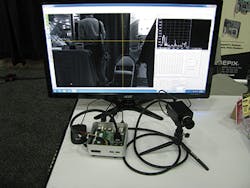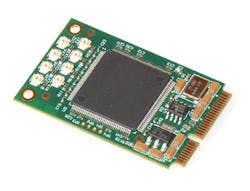Frame grabbers add features and formats
Frame grabbers are available with numerous camera interfaces and formats to meet a range of applications.
Andrew Wilson, Editor
Developers can now choose from a host of different PC-based camera interface boards with which to configure a machine vision or image processing system. These are available with a number of different camera interface standards and PCI-based interfaces that can be paired to meet the needs of any particular application.
While those wishing to build surveillance or medical imaging systems may choose to use cameras with analog or broadcast outputs, high-performance machine vision systems may require deploying cameras with interfaces such as Camera Link or CoaXPress (CXP) and dedicated PC-based frame grabbers.
Just as the number of analog and broadcast standards continue to proliferate, so too does the number of camera to computer interface boards, many of which are based on the PCI standard. Many vision systems may use full height, full-length or half-length PCI Express frame grabbers to interface cameras to computer systems.
Embedded options
For the embedded systems designer, many other options are also available including the use of PMC, XMC and FMC mezzanine frame grabber cards to populate 3U and 6U VME and Compact PCI motherboards (see "Frame grabbers target embedded imaging," Vision Systems Design, April 2014, http://bit.ly/1Inhqxk), stackable PC/104 boards (see "Small-Form-Factor Frame Grabbers Enable Embedded Applications," February 2013, http://bit.ly/1KtR1wX) and PCI Express Mini cards.
Primarily developed for laptop and notebook computers, PCI Express Mini cards are available in form factors that include a full height 30 × 50.95mm and half-height 30×26.8 mm formats. While incompatible with the standard full-size PCI Express slots, these small format boards allow manufacturers to offer different types of camera to computer interfaces as costs as low as a few hundred dollars.
At this year's Defense and Security Symposium held in Baltimore, Maryland in April, Erik Petersen of EPIX (Buffalo Grove, IL, USA; www.epixinc.com) demonstrated the company's PIXCI EB1mini Base Camera Link Mini PCI Express frame grabber integrated into an Intel (Santa Clara, CA, USA; www.intel.com) Next Unit of Computing (NUC) embedded computer (Figure 1). With a 200MByte data transfer rate, the $295 PIXCI EB1mini was shown interfaced to a Base Camera Link camera from Uniq Vision (Santa Clara, CA, USA; www.uniqvision.com). EPIX's XCAP-Lite software was then used to display captured images on an LCD monitor.
Other manufacturers are also leveraging the PCI Express Mini card standard to produce frame grabbers that can capture broadcast video formats. The AVC8000nano, an eight-channel video frame grabber-based on mini-PCI Express from Advanced Micro Peripherals (Witchford, UK; www.ampltd.com), for example, is a full height Mini PCI Express card that allows up to eight NTSC/PAL video inputs to be captured simultaneously (Figure 2).
Captured video data can be streamed continuously to system memory or disk for either immediate local display or further processing. On-board hardware allows the developer to perform such functions as arbitrary video window sizing, cropping and scaling as image data is transferred to the board.
Rather than incorporate an analog broadcast interface, Imperx (Boca Raton, FL, USA: www.imperx. com) has developed a high-definition serial digital interface (HD-SDI) HD-SDI Mini-PCIe card. Although the physical dimensions of the card at 69 x 47mm are larger than a standard mini-PCIe card, the board is electrically compatible allowing developers to view and store images from any SD or HD-SDI compliant video source (Figure 3). Each captured frame can be also be time and date stamped using the company's software suite.
Express lanes
While the Mini PCI Express slot supports a single x1 PCI Express lane, at a (Gen 1) 2.5 transfers/s (GT/s) rate, this is enough to support such camera interface standards as Base Camera Link, NTSC/PAL analog and HD-SDI digital broadcast standards. To support faster camera interfaces such as Camera Link, Camera Link HS and CXP standards, frame grabber vendors must implement multiple PCI Express lanes and Gen 2 (5GT/s) or Gen 3 (8GT/s) rates.
However, just by comparing the data input speed of the analog or digital input signal with the number of lanes implemented on the PCI Express interface to determine whether data can be captured and transferred quickly enough to the host computer can be confusing, as Kevin Brown, Director of Product Marketing with dPict Imaging (Indianapolis, IN, USA; www.dpictimaging.com) points out. While the company's latest Nexeon PCI Express video capture board, for example, implements a x 4 PCI Express lane because there is no x 2 PCI Express lane specification, the on board DM8168 video processor from Texas Instruments (Dallas, TX, USA; www.ti.com) features a single two-lane PCIe 2.0 (5.0 GT/s) endpoint. Thus, the speed of the two lanes is fast enough to allow the board to perform digital capture of analog and DVI/HDMI inputs up to 1080p60 and transfer data simultaneously in compressed and uncompressed formats over the bus.
To support either two cameras in Camera Link Base mode or a single Camera Link camera in Medium, Full or Extended Full Mode, the VisionLink F4 frame grabber from EDT (Beaverton, OR, USA; www.edt.com) employs two SDR Camera Link connectors implemented on a PCI Express x4 Gen2 half height board (Figure 4). This allows up to 850MBytes/s to be transferred from single or dual camera systems to be transferred using DMA to the host computer.
One of the limiting factors of PCI Express-based boards is that many only support two Camera Link connectors. While two or more boards can be used to accomplish this task, manufacturers such as EPIX and Matrox Imaging (Dorval, QC, Canada, www.matroximaging.com) have both developed methods to allow up to four Camera Link connectors to be used.
While the PIXCI E4G2 PCI Express x 4 Gen 2 from EPIX implements two pairs of MDR connectors, one pair on the bracket and the second pair on the rear of the frame grabber (Figure 5), the PCI Express 2.0 x 8 Radient eV-CL Camera Link frame grabber from Matrox Imaging allows developers to add an optional module to support another two Camera Link connector. Both types of configurations require an additional bracket in the PC to support these implementations. Additionally, BitFlow (Woburn, MA, USA; www.bitflow.com) offers the Neon CLQ (Quad CL Base) and the Karbon CL4-F (dual CL Full) along with the forthcoming Axion (dual 80-bit CL).
Faster camera interfaces
With the emergence of high-speed CMOS-based cameras, however, newer camera-to-computer interface standards have emerged. These include the Camera Link HS standard pioneered by Teledyne DALSA (Waterloo, ON, Canada; www.teledynedalsa.com), originally designed to be a replacement for Camera Link) and the CXP standard, a joint development by Adimec (Eindhoven, The Netherlands; www.adimec.com), Active Silicon (Iver, UK; www.activesilicon.com) and Components Express (Woodridge, IL, USA; www.componentsexpress.com) and EqcoLogic that was acquired by Microchip (Chandler, AZ, USA; www.microchip.com) in 2013.
Unfortunately, developing two such disparate high-speed camera-to-computer interfaces initially caused much marketplace confusion, leading systems developers to "sit on the fence" while camera and frame grabber vendors decided which standard to support. Today, while Teledyne DALSA, Matrox Imaging, and Silicon Software (Mannheim, Germany; www.silicon-software.com) have all released frame grabbers to support the Camera Link HS (CLHS) standard, more than 30 vendors offer cameras, frame grabbers and peripherals for the CXP standard (see "CXP cameras, frame grabbers tackle high-speed imaging," Vision Systems Design, January 2014; http://bit.ly/RQrAQD).
To support both these standards requires frame grabbers that feature high-speed PCI Express interfaces. The Cyton-CXP4 frame grabber from BitFlow, for example, incorporates four CXP links each running at up to 6.25 Gigabits/s and a PCI Express Gen 2 x 8 interface. Because these multiple links can be aggregated, a maximum data rate of 25Gbits/s can be achieved and transferred via DMA to the host computer.
This is useful in developing systems that integrate four-channel CXP cameras such as the latest EliiXA 12k x 1 line scan cameras from e2v (Chelmsford, UK; www.e2v.com) that support data rates of 200kHz, a prototype of which was shown at this year's Automate show in Chicago interfaced to the Cyton-CXP4 frame grabber (Figure 6).
Interestingly, Euresys (Angleur, Belgium; www.euresys.com) has taken a different approach, choosing to implement a PCI Express Gen 3 interface onto its PCI Express x 4 CXP Quad G3 CXP frame grabber. By doing so, the board is also capable of supporting up to four CXP links.
While many CXP frame grabber vendors offer products with, one, two or four XP links, Kaya Instruments (Haifa, Israel; www.kayainstruments.com) has taken the concept one step further with its Komodo CXP, a board capable of receiving image data from up to eight CoaXPress links in single, dual, quad or octal modes (Figure 7). Because of this, it can be used to simultaneous capture image data from two quad link cameras at a maximum data rate of 25Gbits/s per camera.
To transfer this data to the host computer, the board incorporates a PCI Express Gen 3 x 8 interface with each channel running at 8GT/s. Like other CXP frame grabbers, the board also provides GPIO for machine control signals, such as triggers, shaft encoders and camera exposure control.
Getting faster
While camera interfaces such as CXP are faster than their Camera Link predecessors, even frame grabbers with four CXP links configurations are not fast enough to support some currently available high-speed cameras. At the Defense and Security show in Baltimore, for example, IO Industries (London, ON, Canada; www.ioindustries.com) demonstrated its Flare 12M180-CX, a 4096 x 3072 four channel CXP camera based on the CMV12000 from CMOSIS (Antwerp, Belgium; www.cmosis.com).
Although the cameras was shown transferring 4096 x 3072 x 8-bit images at 187fps to a quad CXP frame grabber, the full 300fps frame rate of the sensor cannot be supported by a four channel CXP implementation, according to Andrew Searle, Global Sales Manager with IO Industries. "300fps at 10-bits/pixel would require a minimum of eight full-speed 6.25Gb/s CoaXPress links," he says.
Today, cameras with greater than four CXP channels are not generally available, leaving systems developers to wait for the next version of CXP that will increase the current maximum data rate from the existing 6.25 Gbit/s by adding 10 and 12.5 Gbit/s speeds, according to Chris Beynon, CTO of Active Silicon and Technical Chair for CoaXPress of the Japan Industrial Imaging Association (JIIA; www.jiia.org). This doubles the data rate to 5 GBytes/s using a cable with four coax links, or 7.5 GBytes/s using six links (see "CoaXPress cameras and frame grabbers tackle high-speed imaging," Vision Systems Design, January 2014, http://bit.ly/RQrAQD).
Needless to say, to support such data rates, vendors are more than likely to offer multi-lane frame grabbers that leverage the PCI Express 4.0 specification (now under development) to double the data rate transfer speed to 16GT/s per lane.
Companies mentioned
Active Silicon
Iver, England
www.activesilicon.com
Adimec
Eindhoven, The Netherlands
www.adimec.com
Advanced Micro Peripherals
Witchford, UK
www.ampltd.com
Bitflow
Woburn, MA, USA
www.bitflow.com
Components Express
Woodridge, IL, USA
www.componentsexpress.com
dPict Imaging
Indianapolis, IN, USA
www.dpictimaging.com
e2v
Chelmsford, UK
www.e2v.com
EDT
Beaverton, OR, USA
www.edt.com
EPIX, Inc.
Buffalo Grove, IL, USA
www.epixinc.com
Euresys
Angleur, Belgium
www.euresys.com
Imperx
Boca Raton, FL, USA
www.imperx.com
IO Industries
London, ON, Canada
www.ioindustries.com
Intel
Santa Clara, CA, USA
www.intel.com
Kaya Instruments
Haifa, Israel
www.kayainstruments.com
Matrox Imaging
Dorval, QC, Canada
www.matroximaging.com
Microchip
Chandler, AZ, USA
www.microchip.com
Silicon Software
Mannheim, Germany
www.silicon-software.com
Teledyne DALSA
Waterloo, ON, Canada
www.teledynedalsa.com
Uniq Vision
Santa Clara, CA, USA
www.uniqvision.com
For more information about frame grabber companies and products, visit Vision Systems Design's Buyer's Guide buyersguide.vision-systems.com



